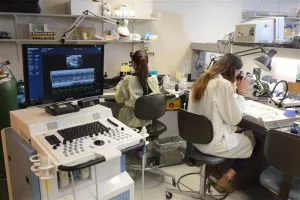The facility is comprised of four separate rooms. The first and largest room is equipped with four independent and fully functional murine ‘operating stations’, each with a surgical stereomicroscope, tabletop gas anesthesia machine for rodent inhalation anesthesia, fiber optic lighting, temperature regulation with feedback control via rectal temperature monitoring, microsurgical instruments, heat pad and heat lamp, glass bead sterilizers, surgical supplies, shaver and weighing scales. In addition, there is a rodent respirator for use in open chest procedures and a Millar pressure volume hemodynamics area associated with one of these workstations. One of these four stations is primarily dedicated to closed chest survival electrophysiology studies.
The second room functions as the telemetry room. This temperature and humidity-controlled site includes the DSI equipment necessary to perform continuous ambulatory telemetric EKG and hemodynamic monitoring along with constant measurement of animal temperature and activity. The current room capacity allows for simultaneous measurement of two groups of eight mice.
A third room houses two Kent Coda mouse tail cuff blood pressure analysis systems with laptop computers and capabilities of noninvasively measuring 12 mice simultaneously.
The fourth room houses a VisualSonics ultrasound machine with an associated tabletop gas anesthesia machine, a heated platform with EKG and a micromanipulator for injections. This area contains two separate anesthesia platforms to enable echocardiography on either mice or rats. The room also houses a Dexa imager capable of measuring bone density and body composition of mice.
The facility also has access to a mouse exercise treadmill capable of exercising six mice simultaneously.
